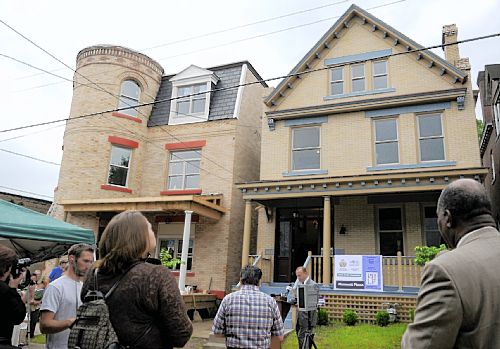
Category Archive: Preservation News
-
PNC Bank Invests $5 million Loan in Landmarks Community Capital Corporation
PHLF News
July 24, 2008PNC Bank, a member of The PNC Financial Services Group, has invested a $5 million loan in Landmarks Community Capital Corporation’s Urban Economic Loan Fund. The Urban Economic Loan Fund provides short-term flexible financing at below market rates to non-profit organizations involved in revitalizing their communities.
Dr. Howard B. Slaughter, Jr., Chief Executive Officer of Landmarks Community Capital Corporation (LCCC) said, “This first investment in the Urban Economic Loan Fund will be the catalyst for more development in urban markets throughout Pittsburgh, where an economic stimulus is important for neighborhood revitalization, which advances more stability and creates viable places to live and work. We are appreciative of PNC’s willingness to invest in the Fund and have already made commitments to utilize this funding.”
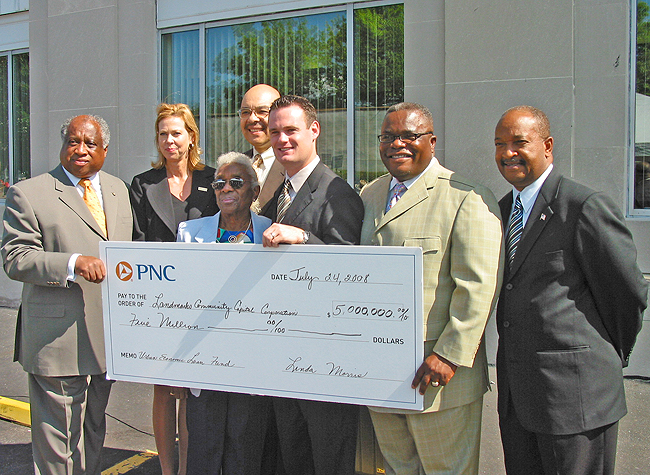
“LCCC has already demonstrated its ability to effectively finance urban development,” said Mayor Luke Ravenstahl. “This significant investment from PNC will allow Dr. Slaughter to help reverse the disinvestment in Pittsburgh’s urban cores and be a differentiating factor in supporting the financing of Pittsburgh’s urban fabric – exponentially and strategically. This will be critical for sustainable urban revitalization.”

Congressman Mike Doyle stated, “This initiative is another important contribution to the revitalization of our community. I want to commend PNC Bank and Landmarks Community Capital Corporation for working together on this Urban Economic Loan Fund.”
City Councilman Ricky Burgess, whose district this is said, “PNC has consistently committed themselves to the communities of the City of Pittsburgh. I am confident that this worthy loan investment will be of great benefit to the urban cores of our great city, and will encourage other organizations to follow suit. My sincere thanks to PNC and Landmarks Community Capital Corporation for their efforts.”
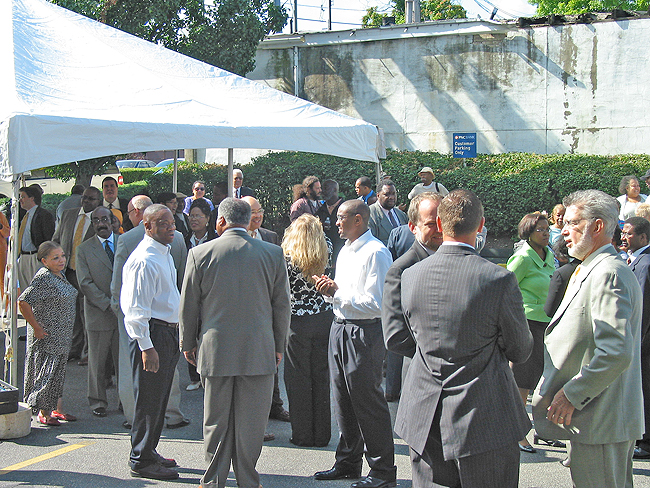
“Landmarks Community Capital Corporation’s loan program supports PNC’s goal of strengthening communities through investments and partnerships with local organizations,” said Linda F. Morris, Senior Vice President & Western Pennsylvania Market Manager, PNC Bank. “Our commitment makes it possible for Landmarks Community Capital Corporation to offer below-market interest rates on loans, which will stimulate initiatives in affordable housing and community development. These are sustainable projects that should have a positive ripple effect throughout the region.”
State Representative Joe Preston said, “I am very pleased that PNC continues to support
the neighborhoods. First by providing banking services, and now reinvesting their dollars in the communities. The leadership at PNC and Landmarks Community Capital Corporation are greatly appreciated.”

State Representative Jim Ferlo stated, “Once again PNC has made a strong statement demonstrating their commitment to the neighborhoods in Pittsburgh. This is a real win-win for our City because we can have the utmost confidence in the stewardship of this commitment as well.
Landmarks Community Capital Corporation’s track record of investment speaks clearly to their dedication to quality projects that meet with their high standards for preservation, sustainability, and green building principles.
I am very excited by what can be achieved through PNC’s outstanding commitment and I applaud Dr. Slaughter’s continued efforts on behalf of Pittsburgh neighborhood reinvestment.”
Scheduled speakers at the press conference include: Mayor Luke Ravenstahl, Mayor of Pittsburgh; Mr. Charlie Batch – President & CEO Batch Development Company, Inc. and Landmarks Community Capital Corporation Board Member; Honorable Ricky Burgess, Pittsburgh City Council District 9; Ms. Linda Morris, Senior Vice President & Western Pennsylvania Market Manager, PNC Bank; Dr. Howard B. Slaughter, Jr. , CEO, Landmarks Community Capital Corporation; Honorable Joseph Preston, Pennsylvania House of Representatives District 24; Honorable Jim Ferlo, Pennsylvania State Senate District 38, Mr. Doug Smith, Sr. Vice-President, Wilbur Smith Associates and Chair, Landmarks Community Capital Corporation Board.
-
Heathside Cottage’s mystery adds to its appeal
By Bob Karlovits
TRIBUNE-REVIEW
Saturday, July 19, 2008 It sits atop Fineview, peering over Downtown like one of the gargoyles that lurk through the house.
It sits atop Fineview, peering over Downtown like one of the gargoyles that lurk through the house.
Jack Miller from the Pittsburgh History & Landmarks Foundation knows some of the history of the home — known as Heathside Cottage — that could have been on its perch before the Civil War. It is dated 1855 on a plaque near its bay window, but continuing research debates that."The story is in the bricks," Miller says with a sigh.
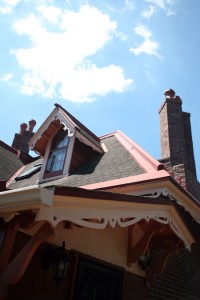 Charm from the 19th century is an obvious feature of the home the foundation has up for sale. The two-bedroom home with solidly repointed brick, plastered walls and decorative wood inside and out is being marketed at $189,900.
Charm from the 19th century is an obvious feature of the home the foundation has up for sale. The two-bedroom home with solidly repointed brick, plastered walls and decorative wood inside and out is being marketed at $189,900.The home, which had a guest spot in Rick Sebak’s 1977 "North Side Story," also has a one-car garage, a stylistically matching shed, a bricked patio and a garden area that once was a dilapidated home next door.
"I love it," says filmmaker Sebak about the home. "It is the kind of house that just makes you want to visit and spend some time there."The home is small with high ceilings in its two main levels, but low ones in the basement where former owner Judith Harvey hung signs saying: "The ceiling is low, the archways lower, anyone over 5 feet, DUCK."
Upstairs, the 10- and 11-foot ceilings give space to rooms that otherwise are tight and small. It is not a home for big parties, big people or big families.
The first floor consists of a kitchen-dining room, parlor and den. Upstairs are two bedrooms and a bath, with a skylight over the staircase adding another touch of airiness to the home.
The outside is dominated by ornate, wooden trim that Miller jokes earned the home the name of the "witch’s house" from neighborhood kids.
Harvey, who is retired, serves as librarian of the Frank B. Fairbanks Rail-Related Archive for the foundation. She moved out of the home at the end of June.
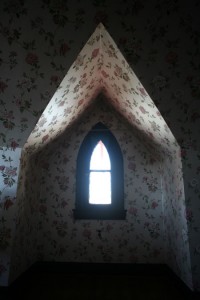 Harvey bought the home in 1992 as a project to restore. After her husband died in 1996, she moved in permanently and continued her work, adding ornamental gargoyles as she went. In 2000, she entered into an arrangement with the foundation known as a retained life estate.
Harvey bought the home in 1992 as a project to restore. After her husband died in 1996, she moved in permanently and continued her work, adding ornamental gargoyles as she went. In 2000, she entered into an arrangement with the foundation known as a retained life estate.Under that arrangement, Miller says, the title of the home was transferred to the foundation, but she retained the right to live there. She remained responsible for taxes and maintenance, but received a charitable income-tax deduction.
She also received a similar deduction this year for the unused part of her donation to the foundation. History & Landmarks officials then received control of the property to manage or market whatever way they wished,
Harvey does not want to discuss matters, but Miller says he believes she simply grew tired the work that comes along with taking care of a property.
Al Tannler, director of historical collections for the History & Landmarks, says no data exists on the construction of the home. But it may be related to a cluster of like homes called Evergreen Hamlet in Ross.
Col. James Andrews, a self-taught stone mason and engineer, bought the Fineview property in 1862, so Tannler believes he "had the home built and may have named it" Heathside, which shows up on a stone above the bay window.
He did work for Joseph Kerr (1816-1888), an architect who designed the Gothic Revival Evergreen Hamlet homes. Therefore, Tannler suggests, Kerr is a likely suspect for the design of Heathside.
That whole story, though, puts it behind the 1855 date, but that doesn’t matter too much, he says.
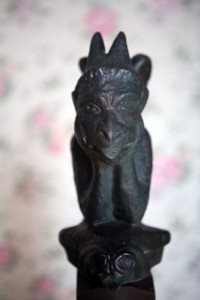 "It’s significance is its rare quality," he says, "and the fact that it is one of a few of its kind."
"It’s significance is its rare quality," he says, "and the fact that it is one of a few of its kind."Bob Karlovits can be reached at bkarlovits@tribweb.com or 412-320-7852.
-
Market Square street closure may alter apartment project
By Jeremy Boren
TRIBUNE-REVIEW
Thursday, July 3, 2008The Pittsburgh History & Landmarks Foundation, a major investor in Market Square’s revitalization, might nix a new seven-unit apartment complex if the Pittsburgh Downtown Partnership sticks to a plan to close some of the square to vehicles.The foundation is spending $3.5 million to renovate three vacant buildings on Graeme Street into Market at Fifth, a plan for seven upper-floor apartments, a ground-floor restaurant and a rooftop garden.
The partnership’s plan would close Graeme, the apartments’ entrance, and nearby McMasters Way as part of a $4.8 million to $5 million Market Square overhaul that, so far, has gone smoothly.
“We do not see how people are going to want to rent apartments on a dead-end street. People do not frequent dead-end streets,” said attorney Anne E. Nelson, who voiced the concerns at a meeting of the city Historic Review Commission.
“If Graeme Street is closed, Landmarks does not know whether it should complete construction of the project,” Nelson said.Arthur P. Ziegler, the foundation’s president, said there’s time to develop the apartments as something else if a compromise can’t be reached and the street is closed.The commission approved Pittsburgh Downtown Partnership’s preliminary plans for Market Square, but members urged the partnership, a nonprofit that represents Downtown business owners, to find a solution with the foundation.
“We’re going to do what’s best for the square,” said Dina Klavon, the designer the Pittsburgh Downtown Partnership hired to guide Market Square’s overhaul.
Klavon said she’s open to changes and plans to meet with Pittsburgh History & Landmarks officials.
“We’re trying to give Market Square back to the pedestrian,” said Mike Edwards, president of the Pittsburgh Downtown Partnership. “Right now it’s a thoroughfare. We want it to be a destination.”
Edwards said renovation of Market Square could start in spring.
The most striking feature about Klavon’s design is that it would make Market Square resemble a one-level European piazza.
The roadway would be flush with sidewalks and outdoor cafes, which would be differentiated by using various types of pavement and cobblestone.
Traffic and parking would be permitted on the perimeter of the square. No traffic would be allowed in the middle, where Market Street and Forbes Avenue meet.
Jeremy Boren can be reached at jboren@tribweb.comor 412-765-2312.
-
Restoration arrives, one home at a time, in Wilkinsburg
Thursday, July 03, 2008 -
Historic review panel OKs Market Square makeover
Thursday, July 03, 2008By Rich Lord,Pittsburgh Post-GazetteWork on pedestrian-friendly project might begin next spring
The proposed $5 million revamp of Market Square got a boost yesterday when Pittsburgh’s Historic Review Commission gushed over the reduced traffic, piazza-type design and nicer trees.
“This will be a miniature Parisian square,” said commission Vice Chairman Paul Tellers, whose motion to approve was unanimously adopted.
The commission put one condition on its approval: It wants project architect Dina Klavon to meet with the Pittsburgh History & Landmarks Foundation to discuss concerns about the closing of alleys running from the square to Fifth Avenue.
The foundation is spending $3.5 million renovating four buildings near the square, and some of the second- and third-floor apartments would be accessed via one of the alleys, Graeme Way.
“If people want to drop other people off, or unload things to their apartments, they can’t get there,” said Anne E. Nelson, the foundation’s attorney.
Also closed to cars would be McMasters Way. Cars would be able to enter the square using Forbes Avenue and Market Street, and could drive around its perimeter. They could no longer drive through its center.
“We’re trying to give Market Square back to the pedestrians,” said Pittsburgh Downtown Partnership President Mike Edwards, whose group is leading the charge to repair the square. “Right now, it’s a thoroughfare. We want it to be a destination.”
The redesign would replace the network of streets, curbs and raised tree planters with a flat, curbless surface. Commission members questioned whether that would be safe, but accepted Ms. Klavon’s contention that paving walkways with brick, plaza areas with terrazzo and streets with granite squares called Eurocobble would safely separate people from cars.
They also wondered whether “interactive” lighting that changes as people walk by it was really necessary to create a “wow factor.”
“The elegance will be the wow factor,” said commission Chairman Michael Stern.
Construction could start in the spring, said Mr. Edwards.
Rich Lord can be reached at rlord@post-gazette.com or 412-263-1542.First published on July 3, 2008 at 12:00 am -
Start of revitalization effort generates enthusiasm in Elizabeth Borough
By Margaret SmyklaThursday, July 03, 2008Pittsburgh Post GazetteAllegheny County’s new small-business revitalization program, Allegheny Together, is in the initial stages in Elizabeth Borough, but it already has made a difference.
“Some people are so excited they have started making changes,” said Carol Hill, president of the nonprofit, all-volunteer Elizabeth Area Community Development Corp.
“It has motivated business owners to take another look at their buildings and realize the value of maintaining and restoring them,” said project manager Jessica Mooney.
The other pilot communities are Swissvale, Stowe and Tarentum.
In September 2007, the county launched Allegheny Together, a small-business revitalization program designed to encourage well-planned, well-designed and geographically focused investment in established commercial districts.
The target is the central business district in Elizabeth Borough, which extends 2 1/2 blocks, from Market Street to Strawberry Street. Businesses within that area include Rockwell’s Red Lion Restaurant, Mitchell Plumbing & Heating, PNC Bank, Variety Video, Barton’s Flowers and Gifts, Rite Aid and The Grand Theatre, a renovated movie theater for community events.
The district also houses the borough building, Elizabeth Elementary School, an office of state Rep. David Levdansky, D-Elizabeth, and other office space.
For the first year of the three-year program, the county hired Pittsburgh History and Landmarks Foundation and Town Center Associates to provide technical assistance to the communities. Among the offerings were complimentary architectural design services for facade renovations and information on applying for facade improvement grants and small business loans.
The program kicked off publicly in January for business owners, and four workshops followed, focusing on design, organization, promotion and business development.
Ms. Mooney said the selection of the borough for the program “was a natural progression from the recent commercial revitalization study by the Department of Economic Development.”
That $40,000 study to improve the borough’s downtown district contained recommendations that council President Monica Douglas called “a blueprint for the future.”
They ranged from the costly building of a boardwalk along the Elizabeth Bridge and the Monongahela River, to less expensive bridge lighting, new signs and planters.
Ms. Mooney said the objectives of the program’s second year are to execute initiatives identified in the annual action plan and develop an action plan for the third year. The final year also involves developing a strategy for long-term sustainability.
Mrs. Hill is confident in the program’s goal of making the once-thriving district successful again.
For more information, visit www.alleghenytogether.com.
Margaret Smykla is a freelance writer.First published on July 3, 2008 at 6:22 am -
Public Hearing at Historic Review Commission on Redesign of Market Square
PREPARED TESTIMONY OF
ANNE E. NELSON, ESQ.
GENERAL COUNSEL
PITTSBURGH HISTORY & LANDMARKS FOUNDATION
BEFORE HISTORIC REVIEW COMMISSION, CITY OF PITTSBURGH
PUBLIC HEARING ON MARKET SQUARE REDESIGN
JULY 2, 2008
Landmarks is investing $3.5 million to restore four historic buildings in Market Square located between Market and Graeme Streets, the design of which was predicated on Market and Graeme being open to vehicular traffic from Fifth Avenue into the Square. This project includes retail on the first floor and seven affordable apartments on the upper floors that will use Graeme Street as an entrance. We will have a green roof and are doing the buildings to LEED standards.
However, the redesign plans chosen close Graeme Street and that has us alarmed. We do not see how people are going to want to rent apartments on a dead end street. People do not frequent dead end streets; they want the ability to bring people to the door, load and unload things. Furthermore, how will the trash be collected?
Historically, Market Square has always had full traffic access. Removing traffic from the street has worked almost nowhere in the United States and almost every street where traffic was removed has been reconverted to have traffic flowing again in order to bring people back. Examples of traffic removed include East Liberty and Allegheny Center in Pittsburgh, and traffic was eliminated on Chestnut Street in Philadelphia and Fourth Street in Louisville and both lost retail and now have it back since traffic was reopened.
If Graeme Street is closed, Landmarks does not know whether it should complete construction of the project. I ask you, would you like to live on a dead end street that has no provisions for dropping off or turning around? When thinking about this question, remember that in Pittsburgh during a lengthy part of the year, the days are short and the weather is bad.
We question our investment of $3.5 million in Market Square if Graeme Street is closed.
-
Public Hearing on St. Mary’s Academy Building
PREPARED TESTIMONY OF
ANNE E. NELSON, ESQ.
GENERAL COUNSEL
PITTSBURGH HISTORY & LANDMARKS FOUNDATION
BEFORE HISTORIC REVIEW COMMISSION, CITY OF PITTSBURGH
PUBLIC HEARING ON ST. MARY’S ACADEMY BUILDING
CITY HISTORIC STRUCTURE NOMINATION
JULY 2, 2008
Pittsburgh History & Landmarks Foundation (Landmarks) strongly supports the nomination of the Academy Building of the St. Mary’s Church complex to become a City-Designated Historic Structure.
The St. Mary’s Academy Building was listed on the first county-wide architectural survey conducted in the United States, undertaken by Landmarks in 1966, and chosen as one of the buildings published in Landmark Architecture of Allegheny County Pennsylvania by James D. Van Trump and Arthur P. Ziegler, Jr. The Academy Building was also listed in 1979 in the second countywide survey of historic architectural sites conducted by Landmarks, in association with the Commonwealth of Pennsylvania. It was chosen for inclusion as one of 600 out of the 10,000 surveyed in the major book based on this survey, Pittsburgh’s Landmark Architecture by Walter C. Kidney, published in 1997. Both Van Trump and Kidney consider the Greek Revival c. 1850 Academy Building a significant surviving example of an important American architectural style. Furthermore, its “curious ornamental cast iron porch” is “the sort usually associated with New Orleans or Mobile although once common too in the industrial North.”
In 1989 historian Roger Kennedy noted in his National Trust book Greek Revival America: “The Northern Greek Revival was at least as vigorous and diverse as that in the antebellum South; but all the great houses of the North … have fallen victim to that region’s industrial success.” This is also true of banks, courthouses, and modest Greek Revival structures like St. Mary’s Academy, and we should protect the limited number of survivors.
Of the buildings in the St. Mary’s Church complex, the Academy Building is not only the oldest, but is the most architecturally unique and should, therefore, be deemed a City-Historic Structure.

